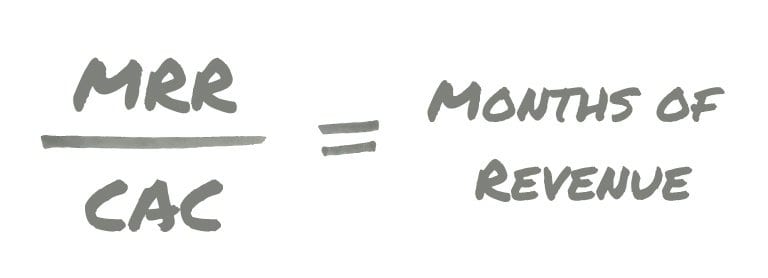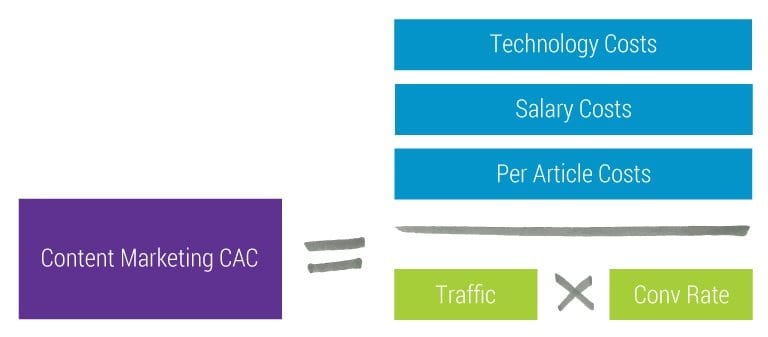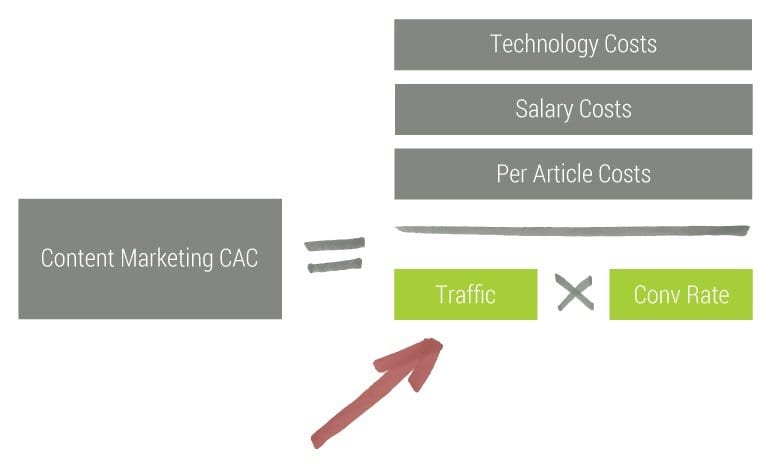 One of the more frequent questions we hear from marketers and executives alike is: “We have no idea what our return on content marketing spend is…”
One of the more frequent questions we hear from marketers and executives alike is: “We have no idea what our return on content marketing spend is…”
(Or at least some variation of the ROI they are getting on their investment in content marketing.) And it’s an entirely valid question.
When you’re investing heavily with your company’s valuable time, money and brain power – you should have a clear idea of what you are getting back in return for that investment
If you aren’t clear about your return, don’t feel bad. It’s incredibly common.
You’re publishing quality content and getting some traffic from it. You’re sending emails and scheduling social posts. And hey – hold the phone – people are reading and sharing your content. That’s where you start to think, “My content must be working!”
Until you or your boss questions, “Is our content worth it?” or “Are we getting any customers and how much are we spending?” That’s where you might get that deer in headlights look and start fumbling for the first response that comes to mind:
“Sales said customers are bringing up blog posts, so…”
“People are opening our emails, so…”
“Look, you can’t really quantify brand awareness…”
If you’re this marketer, it would be a lot easier for you to point to a spreadsheet and say, “Here is how much each customer costs us from content marketing.” It’d be even better if you could add how that’s driving growth and how you expect blogs to compound over time.
If you’re the founder or executive, you would feel a lot better off about your content marketing investment if your content team had these metrics all ready for you.
Bottom line, you have cash and employee time at your disposal to grow. But is spending a majority of both on content really worth it?
So, that’s what we are here to dive into.
Getting the Spreadsheet: We’ve built this analysis around a spreadsheet model to help you calculate your CAC from content marketing.
You can use the model and the analysis in this post to calculate your own company’s CAC, which means you’ll stop guessing, start measuring, impress your CEO, and figure out how to lower your acquisition cost from content marketing.
What is Considered a “Good” Acquisition Cost?
To help give you context, let’s start by diving into what numbers are reasonable for acquisition cost: $1? $100? $1000?
Unfortunately, the answer to what makes a good CAC is one you probably don’t want to hear: it depends.
But it depends because the value of a single customer to your company is different for every business. The value of a customer is often represented in one of two ways:
- Monthly Recurring Revenue of One Customer (MRR)
- Lifetime Value of One Customer (LTV)
A “Good” Acquisition Cost Compared to Lifetime Value
Some say CAC < LTV defines a good acquisition cost, but that’s not always the case. If your LTV is $100 and your CAC is $99, which means you’re making $1 after you’ve assumed the cost to acquire them — not great.
Even if we bump the numbers to $300 CAC on a $350 LTV, it’s not clear your business is “good” or even profitable because you have to factor in all the other costs that go to keeping your business running.
Basically, it’s up to you and the subtleties of your business to decide what CAC/LTV ratio is you should consider “good.”
But that leads us to the other way to understand if your CAC is “good.”
A “Good” Acquisition Cost Compared to Monthly Revenue
This method is more intuitive for most people. Here, you need to determine how many months will it take to make back your acquisition cost? After you’ve acquired the customer and they are a recurring buyer, you won’t have to ‘spend’ to keep acquiring them (so the revenue gained is mostly profit).

So what how many months is acceptable to make your cost of acquisition “good?”
Various founders and marketers on Quora estimate to around 18 months is typical for large enterprise businesses and anywhere from 6 to 12 months is better for smaller consumer companies.
The months of revenue you’re willing to devote to acquiring a customer is dependent on how long your customers remain a customer, also known as churn rate. If it takes you $100 to acquire a customer and you get $10/month from that new customer, BUT that customer only stays a customer for ten months – then you’ve broken even and won’t have made any profit to cover other business expenses.
Calculating Acquisition Cost from Content Marketing
At its core, CAC is a pretty simple calculation: add up all your costs, divide that by the number of customers you get from spending that money.

But let’s break it down a little bit further.
Costs of Content Marketing
Figuring out this number will represent the majority of the work you’ll have to do. We’ve broken it up into three categories:
- Costs per article– This includes writer costs, any images per article, etc. (You can attribute partial costs here.)
- Salary Costs– Full-time employee salaries, any developer time, and/or agency costs.
- Technology/Tool Costs– Email outreach software, SEO software, and anything else used for content marketing. (You can attribute partial costs here.)
If you look at the spreadsheet, we’ve calculated these expenses as monthly costs.
1. Costs per Article
Writers are the main cost here. So if whoever runs content writes all of your posts, and you don’t spend money on graphics, this number could be zero.
In our spreadsheet model, I’ve used a per article cost of $300.
(Don’t get too hung up on this example provided. It’ll depend on your industry, length of pieces, research required, the value of the piece of content, etc.)
2. Salaries
This will usually be the bulk of your content marketing costs.
In the examples, we’ve used a business that outsources their content marketing, annualized at $2,708/month. Plug in whichever category you fall under.
3. Technology/Tools
It just doesn’t cost a lot, tech-wise, to run a blog. But the more tools you leverage can make your blog more successful.
The only way this category can make a big dent in your content marketing budget is if you use an expensive inbound automation tool like HubSpot or equivalent. Even then, these “automation” tools can save a significant amount of time and provide you a competitive advantage over your digital competition.
All in all, if any of the small tools save your content team time, that’s a tradeoff you should be making.
Customers Acquired from Content Marketing
Remember, CAC is costs divided by acquired customers, so now let’s talk about the denominator.

We’ve modeled this using two conversion rates since this is how most funnels from content work. Traffic comes to your blog, you convert that traffic into leads, and then you convert your leads into paying customers.
You just multiply these three numbers together, and the end result is the number of acquired customers from your blog traffic. You can use unique visitors (or “Users” in Google Analytics) per month for visitors, percent of traffic converted to leads and percent of leads that convert to paid customers.
Now, most content marketers get hung up on two things when doing this calculation. Let’s discuss each issue.
Issue #1: “How Do I Know How Many Leads my Blog Generates?”
This concern could be a post within itself, but the easiest/quickest way to do this is to have a unique “success” page where visitors becomes a lead. For example, if they fill out a form, subscribe to an email list, or signup for a trial, you can send them to a thank you page that will attribute the original page responsible for the conversion.
Then, assign that page as a goal in Google Analytics, and you can get a report that will tell you how many people got to this conversion page from where they came from. Or if you do have marketing software like HubSpot, determining conversions down to specific blog posts are incredibly simple.
Issue #2: “But Our Content Converts Customers Over Long Periods!”
Yes, customers may not read a blog post, then download a trial, and then close into a customer.
But if the goal of your content is only used as a “brand building/nurturing” endeavor, this post isn’t for you.
The same concept is similar for advertising. If U-Haul spends $1 million a year on advertising, it is going to drive more customers. But it’s going to be somewhat complex and challenging to determine what exactly their ROI is on that advertising spend.
Again, marketing software like HubSpot allows you to attribute the first source that brought a customer to you. If, say, someone visits a blog of yours, and then takes several different actions over an extended period of time (but does eventually become a customer), HubSpot will show you which blog is responsible for your new customer.
Just know that if you don’t have this software and are using something like last-click attribution, that you are calculating the highest possible CAC, meaning you can make this argument, “CAC is even lower than my calculations because I’m not counting all of the ways our content is generating customers.”
Now, the acquired customers portion of our equation is again pretty simple:
That means the number of customers acquired is linearly dependent on all three factors above, equally.
Once you have your totals costs metric, and your total customers acquired metric, divide the former by the latter. And voila! You know have the amount of money it takes you to acquire a customer through content marketing.
Factors that Affect CAC of Content Marketing
One of the largest factors on your CAC for your content efforts is the amount of traffic you bring in and how well you convert that traffic down the funnel into paying customers.
For example, 10,000 monthly unique visitors at a 1% overall conversion rate is the same number of customers as 5,000 monthly customers at a 2% overall conversion rate. Traffic and your conversion rates are important factors that can greatly affect your content marketing CAC. Remember this.
As we said above, people (salaries) are expensive. Salaries are another factor that can significantly affect your CAC for the content you create. The more people on your team equals the higher your costs to acquire customers. Plain and simple.
Interestingly, if you’re a one-person show or startup team that is building a company while you have other jobs or are funding your salary outside of the business, producing a blog that draws steady, converting traffic is a home run for CAC of content marketing. (But this means you have to create and produce content for a blog on top of everything else on your plate.)
We can’t get into all the what if scenarios, but feel free to email [email protected] with any specific questions you may have.
Questions? Ask away in the comments, we usually respond to every single one.
